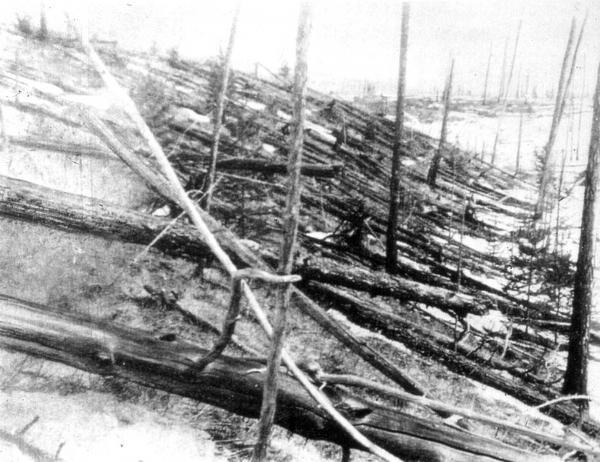Consolidating the hypothesis that the Tunguska explosion in 1908 was caused by comets
New Cornell University study, the United States is almost certain that the 1908 Tunguska explosion was caused by a comet falling into the atmosphere. The explosion is devastating to 830 square miles in the Siberian forest. This conclusion is evidenced by an uncertain source. It was smoke from NASA's shuttle that was launched in a century after the explosion.
The Geographic Society of America published its research in Geophysical Research Letters, dated June 24, 2009. Accordingly, people associate these two events based on what happened the following day: the emergence of noctilucent clouds. The composition of these clouds is ice molecules and they only form at very high altitudes and are extremely cold.
Michael Kelley, a professor of engineering at Cornell University, who led the study, said: 'The work we are doing is like reassembling the plot of a mysterious murder that happened 100 years ago. There has been relatively convincing evidence that the earth was hit by a comet in 1908. ' Previously there was a lot of speculation about the cause of this explosion, from comets to meteorites.
One day after the explosion, luminous clouds were seen even thousands of miles away. Scientists explain the phenomenon as follows. First, the ice nucleus of comets erupts an enormous amount of water vapor into the atmosphere. Later, steam accumulates in the whirlpools with tremendous energy caused by two-dimensional turbulence.
Noctilucent clouds are the highest clouds on earth. They form naturally in the middle of the atmosphere of the two polar regions during the summer months. This is when the temperature in the upper atmosphere is -180oF (about -117oC).
The researchers say the shuttle also discharges smoke similar to the operation of comets.
 In 1927, Professor Loenid Kulik took the first picture of the devastated taiga after the Tunguska disaster. (Photo: Professor Loenid Kulik)
In 1927, Professor Loenid Kulik took the first picture of the devastated taiga after the Tunguska disaster. (Photo: Professor Loenid Kulik)
A space shuttle trip sprayed 300 tons of steam into the earth's upper atmosphere. Water molecules are found to travel to the North and Antarctic regions, where these water molecules will form clouds after settling down to the middle of the atmosphere.
Kelly and her colleagues saw the cloudy phenomenon several days after the shuttle Endeavor (STS-118) was launched on August 8, 2007. Similar cloud formation was also observed after shuttle launches in 1997 and 2003.
After the explosion in 1908, (commonly known as the Tunguska Event), throughout Europe, especially in England, which was 3,000 miles away, the sky was shining for several days.
Kelly said that he was intrigued by what those who saw the phenomenon then told. He concluded that the bright sky must be the result of glowing clouds. Comets burst at the same height with the smoke emitted from the shuttle after launch. In both cases, steam is released into the atmosphere.
Scientists are trying to explain how water vapor travels such a long distance without being dispersed or diffused . This cannot be explained by the traditional laws of physics.
Kelly said: 'There must be some way to move this material away tens of thousands of miles in just a very short time. No model can explain this. This is still a completely new and unexpected challenge to the physics industry. '
This new law of physics is linked to the question of extremely powerful reversing vortices. Once the steam meets this vortex, they will move extremely fast, about 300 feet per second.
Charlie Seyler, electrical engineering professor and co-author of the study, said scientists have long been studying the structure of the wind in the upper regions of the atmosphere. This is very difficult to do if using traditional methods such as reconnaissance missiles, air balloons and satellites.
Seyler said: 'From the observation, we find that the current understanding of the atmosphere is very limited.'
The study also involved physicists - Dr. Miguel Larsen, Clemson University and Kelley's alumni. Works conducted at Cornell School are funded by the National Science Foundation's Atmospheric Science Division.
On July 1, Kelly will give a speech on this issue during the annual plenary meeting at Sante Fe, NM
Refer:
Kelley, MC, CE Seyler, and MF Larsen.(2009), Two-dimensional Turbulence, Space Shuttle Plot Transport in the Thermosphere, and a Possible Relation to the Great Siberian Impact Event.Geophys.Res.Lett, (in press) DOI: 10.1029 / 2009GL038362
- Found evidence in the Tunguska case?
- Tunguska event mystery
- The mysterious Tunguska event for more than a century
- Announcing the mystery of the Tunguska explosion
- Discovering asteroids that are about to fly close to Earth
- The meteorite explosions
- Did comets cause extinction in ancient America?
- The mystery surrounding the explosion is equivalent to 185 atomic bombs in Russia
- The secret of the Tunguese explosion
- The decipherment of the 'space death' caused the Earth to fall into ruin: Scientists crazy!
- New hypothesis about the solar system
- Comets cause huge fire rain on Earth
 Is the magnetic North Pole shift dangerous to humanity?
Is the magnetic North Pole shift dangerous to humanity? Washington legalizes the recycling of human bodies into fertilizer
Washington legalizes the recycling of human bodies into fertilizer Lightning stone - the mysterious guest
Lightning stone - the mysterious guest Stunned by the mysterious sunset, strange appearance
Stunned by the mysterious sunset, strange appearance